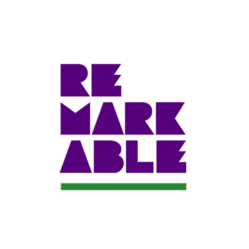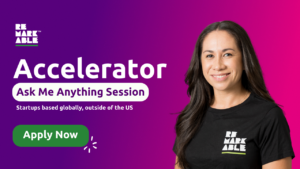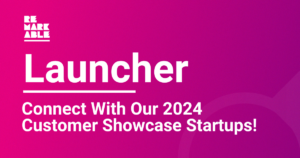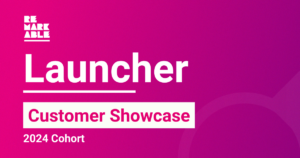Our Operations and Community Manager, George, loves finding technical solutions to problems so while we’re all working from home he has written a few tips on how to use technology to allow us to carry on as business as unusual.
Are you looking for ideas on how to adapt a face-to-face learning program to go online during the pandemic?
Here at Remarkable, we are four weeks into our #SYD20 accelerator program and we have had to adapt, make changes to our ways of working and think differently, and maybe some of the changes we’ve made and tools we’ve adopted might help you too.
Running an entire accelerator program online with seven startups, 14 founders, nine startup team members, 17 keynote speakers, 30 mentors, and six Remarkable team members, is by no means an easy feat. But we are lucky to have access to some incredible systems, tools, and processes to make things run that little more smoothly.
Let’s dive a little deeper into our tech stack before turning our thoughts to a human way of thinking during this time of isolation and virtual communication.
Have you heard of this new SAAS tool?
There are more tools on the market today than ever before and in this new virtual world, we have seen the entrepreneurs among us creating new platforms to help combat our new everyday problems. Let’s look at three aspects of our accelerator program, Planning, Communicating and (Visual) Human contact.
1. PLANNING
When it comes to planning an accelerator program, gone are the days of using spreadsheets, documents and calendars. Siloed information and data is a thing of the past and with this, having tens of tabs open at once just to stay on top of things. There are a handful of tools on the market to help combat the mess: Asana, Confluence, Notion, Monday.com just to name a few we’ve tried. But one tool that stands out to us is Airtable.

Airtable is Remarkable’s ‘mission control’ and is home to everything from a startup team’s contact details, weekly feedback from and about the startups, our program calendars, mentor network contact lists and more. Keeping all information in one place and linking relevant records creates a seamless and easy to use information base. Airtable’s built-in ‘blocks’ are a set of easy templates that allow us to view our program information in useful ways such as graphs of NPS scores over time, a Gantt chart of our program workshop dates and the resources required, even an easy way for us to see which mentors have been matched with which startup founders and why. It all reflects real-time data, meaning nothing is lost, reports can be generated on the fly, and no key information is missed.
Tip… Activate beast mode by unleashing Zapier and automate tasks that you find yourself repeating on a daily/weekly basis.
2. Communication
Where would we be without Slack!? There is no question that running anything virtually without a team messaging platform would be a logistical nightmare. Slack reduces email clutter, keeps relevant information in one place and means that nothing is ever missed. Here at Remarkable if Airtable is the brains of the operation, Slack is the eyes and the ears. We have over 100 active members and in any given month we see slack traffic reach well over 4,000 individual messages.
The schema we use for our Slack channels is:
| #syd20 | A private channel everything the Remarkable team and the whole #SYD20 cohort need to discuss |
| #cptoys, #geckotaxx, #handi etc… | A private channel for each startup in the cohort, for the startup team to message with each other, for our team or their mentors to message just that startup’s team without the rest of the cohort seeing. |
| #productsprint, #salessprint etc… | Public channels for each of our themed ‘sprint’ weeks which includes the cohort startups, Remarkable team, their mentors and subject matter experts who work with the teams just during these sprints. |
| #mc-custacquisition, #mc-customerdiscovery, mc-productdemo | Public channels for each of the program masterclasses – a half day workshop with presentation and team assignments. Work is posted here, copies of presentation decks, video recordings, etc. |
| #events, #hiring, #reading_watching, #tools etc | Public channels for specific perennial topics so that founders, mentors and Remarkable team can all share great resources, tips and ideas |
| #alumni | Public channel for startups from our previous cohorts continue to help each other out, help mentor our latest cohort, and seek help from the Remarkable team and mentors. |
Slack Tips:

- Encourage the use of message threads rather than clogging up channels with inline replies.
- Airtable can post a message automatically to Slack whenever data changes in Airtable. We’ve set them up so that when a startup completes their weekly WIP report on Airtable, it posts the report directly to the #automation_updates channel on Slack.
- While we don’t currently do it, we can also use Zapier to update information in Airtable from Slack. For instance, we could have a bot in Slack that asks founders to give us a ranked score on how they’re feeling today and have it update the founder’s record on Airtable.
- Google Calendar can be integrated with Slack to give everyone yet one more reminder that their next Zoom call is starting soon.
- Encourage everyone to fully complete their profile on Slack, including a headshot (of their actual face, not some cartoon character), startup name, team role, email and phone number. It’s hard enough to build lasting relationships between people online without people being hard to recognise and harder to reach.
ZOOM TIPS:
- Visual presence
It’s all well and good having things organised and being well connected behind our keyboard but when it comes to humanising virtual life nothing comes closer than a virtual meeting. We, like so many others, use Zoom as our video conferencing tool. Breakout rooms, waiting rooms and virtual whiteboards are among some of the features that we use to make a group video session more useful.
If we can’t see or hear you, we can’t help you. There’s not much we can do about the quality of a founder’s home internet connection or the kitchen they’re connecting from but there are still some things we can do to help.
We’ve sent a number of care packages in the mail to our startup founders since the program began. In the first care package we included a Logitech C930e webcam for each founder. It was recommended as producing a much better video image than most laptop and PC cameras, can be swivelled if the user’s monitor is not directly in front, has a built-in light and high-quality microphone. It took a bit of work to find the 30 we needed and they weren’t cheap but we were able to get a bit of a discount for ordering so many at once.

Tip… Use the participant view on the host account to keep control of attendee’s microphones and mute them when necessary. No one likes random background breathing, eating or barking dogs.
- More breaks
One of the things we’ve learned the hard way is that masterclasses, workshops and group work online are harder for most people than in-person. People may be interrupted by their children, pets and home-working spouses or housemates. Someone may start operating a leaf blower just outside their window. And just wearing those headphones and staring at that screen seems to be more tiring than sitting in a workshop room watching and listening to someone in real life.
So we’re experimenting with taking more breaks during the course of a workshop, sprint or masterclass, trying to keep each unit of work to about 45mins with a 10min break (and allowing 5mins for stragglers and dodgy internet connections).
- Listening is harder
We think we’ve also observed that listening for long periods of time is harder and founders may not naturally take notes. So we’re collaborating with our subject matter experts who join us to teach masterclasses to see if there are ways we can switch a masterclass that’s mostly about listening toward something which is partly listening, partly doing, to make sure we’re embedding more of the learning after the Zoom call has ended.
Tip: When you ask a cohort of startup founders to applaud to thank someone who’s just delivered a great class, remember that everyone can only hear one person clapping at a time because of the way Zoom handles audio. So, experiment with creative ways of visually expressing gratitude, with, say, video high-fives, waves, or dance moves.
- Main rooms and breakout rooms
Breakout rooms are a double-edged sword in Zoom. In theory, it sounds great that you can put subsets of 30 people into separate rooms of four or five people so they can collaborate on a shared goal, or get to know each other better. In practice, there is a lot of shuffling of people to do, and a bit of waiting for the people involved as the admin of the Zoom call moves each person to their breakout room.
Make sure your admin person is ready to start (perhaps via the Zoom chat window) before announcing that it’s time to move into breakout rooms. Ask participants to return to the main Zoom room or to ping you in the chat window if they have questions/problems in their breakout room they need help with, or they may sit there in the breakout room twiddling their thumbs, not realising they’re allowed to ask for help.
And when a breakout room ends, you can decide on the length of time it takes before returning participants to the main room, make sure you leave enough time for the participants to finish up and capture everything they were working on (note: no video recordings are kept of breakout room discussions) so it’s a good idea for the admin to drop someone into each breakout room with 5mins, 2mins and 1min to go, just to give the teams a heads-up that they need to finish and capture their work/resolve any unresolved issues. Alternatively use the breakout room chat feature to communicate with all rooms.
3. Hello? are you there? (human contact)
We are all feeling further away from one another than ever before, the morning coffee catch up rituals are a thing of the past and Friday team drinks are a distant memory. As much as technology is great, one thing that comes with technology is the lack of personal connection and in these times this is what we all need most.
Here are just a few ways we at Remarkable try to make things a little more personal.
- Personal Check-ins: Zoom calls are great but nothing beats getting a phone call out of the blue from someone checking in to make sure you’re ok. On any given week you will find the Remarkable team picking up the phone and reaching out to our network for check-ins. Tip… Try not to spend all the conversation talking about COVID-19 but encourage people to talk about what they need to talk about by trying to ask open-ended questions — “How have you been feeling?” is better than “How are you feeling right now?” and also better than, “Are you feeling a bit overwhelmed and stressed?” None of us are therapists and have no business offering therapy though, so our parent organisation, Cerebral Palsy Alliance, makes its employee counselling service available to our startup founders and the Remarkable team, for which we’re very grateful.
- Look out for each other: We’re all in this together and it’s not always about work. In an office environment, we would catch up with one another about our weekends, our pets, our hobbies and everything in between. It’s a little harder to facilitate this virtually but tools like hallway.chat make a good start at bringing people together outside of fixed meetings. Tip… Start your next meeting with a 5 minute icebreaker where work talk is forbidden. Icebreaker.video is a fun tool for automating the icebreaker process online.
- Don’t hide behind your screen: It’s so easy to sit at our desk when presenting on zoom but we wouldn’t dream of sitting behind our desk to present in a room full of people, so why do we do it virtually? We encourage all keynote speakers to move away from their cameras when presenting to enhance body language and interaction. Tip… Play around with the settings in your video client to maximise microphone quality when standing back from your computer. It may be necessary to ensure they have wireless earbuds.
As we all continue to embark on this new and uncertain way of working it’s important to remember that we are all human and that as much as technology helps us to run our business in this virtual world, now is the time to think about being human.



